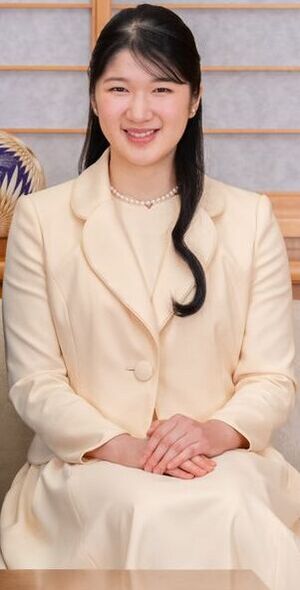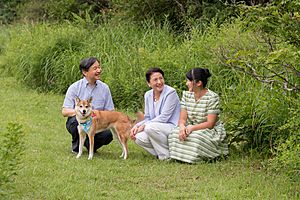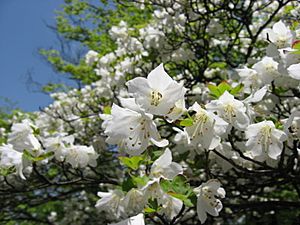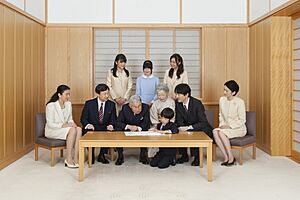Aiko, Princess Toshi facts for kids
Quick facts for kids Aiko |
|
|---|---|
| Princess Toshi | |

Aiko in 2022
|
|
| Born | 1 December 2001 Imperial Household Agency Hospital, Imperial Palace, Tokyo, Japan |
| House | Imperial House of Japan |
| Father | Naruhito |
| Mother | Masako Owada |
Princess Aiko, also known as Princess Toshi, was born on December 1, 2001. She is a member of the Imperial House of Japan. Aiko is the only child of Emperor Naruhito and Empress Masako of Japan.
After her birth, there was a discussion in Japan about changing the rules for who can become emperor or empress. The old rule, called agnatic primogeniture, meant only males could inherit the throne. Some people wanted to change this so a female, like Princess Aiko, could also become empress.
However, in September 2006, Princess Aiko's uncle, Prince Akishino, had a son named Hisahito. Prince Hisahito then became second in line to the throne after his father. Because of the current rules, Princess Aiko cannot become empress. But discussions about allowing women to rule in the future are still ongoing.
Contents
Princess Aiko's Birth
Princess Aiko was born on December 1, 2001, at 2:43 PM. She was born at the Imperial Household Agency Hospital in the Tokyo Imperial Palace. She is the first and only child of Emperor Naruhito and Empress Masako.
Breaking from an old tradition, her parents chose her name instead of her grandfather, Emperor Akihito. The name Aiko comes from an ancient Chinese teaching. The name Aiko means "a person who loves others." Her imperial title is Princess Toshi, which means "a person who respects others."
Princess Aiko's Education
Princess Aiko started kindergarten at Gakushūin on April 3, 2006. She finished kindergarten on March 15, 2008. After that, she went to Gakushuin Primary School.
When she turned eight, people learned about her hobbies. She enjoyed writing Japanese characters, practicing calligraphy, and playing the piano and violin. She also liked to jump rope and write poetry.
In early March 2010, Aiko stayed home from school for a while. This was because she was having trouble with some boys at school. She slowly returned to school starting on May 2, 2010. A palace official said she attended a few classes with her mother, as advised by a doctor.

In November 2011, Princess Aiko was in the hospital because she had pneumonia. In 2014, she started at Gakushuin Girl's Junior High-school.
In the summer of 2018, she traveled alone for the first time outside Japan. She went to a summer program at Eton College in the United Kingdom. Reports said that Aiko supported her mother, Masako, when Masako became empress.
In February 2020, she was accepted into Gakushuin University. She studied Japanese language and literature there.
Princess Aiko graduated on March 20, 2024. She said she would try to balance her official duties and work. She also wanted to fulfill her duties as a member of the Imperial Family. Her final university paper was about Princess Shikishi and her waka (classical Japanese poetry).
Princess Aiko's Public Life
When Princess Aiko turned 16, she started going to public events with her parents. She was too young to attend her father's ceremonies when he became emperor.
On September 15, 2021, Aiko and her parents moved from the Akasaka Palace to the Tokyo Imperial Palace.
On December 5, 2021, a few days after her 20th birthday, she took part in formal coming-of-age ceremonies. She wore a tiara borrowed from her aunt, Sayako Kuroda. Her father, Emperor Naruhito, gave her the Grand Cordon of the Order of the Precious Crown.
She attended the 2022 New Year celebration at the Imperial Palace. This was her first public event as a working member of the imperial family. Her first press conference was on March 17, 2022. On November 5, 2022, she attended a Gagaku concert with her cousin Princess Kako of Akishino. This concert was organized by the Imperial Household Agency. On November 24, Princess Aiko visited an exhibition at the Tokyo National Museum with her parents.
Princess Aiko visited Ise Jingu on March 26, 2024. She offered tamagushi to Amaterasu, a sun goddess. On March 27, she visited the tomb of Emperor Jimmu in Kashihara, Nara. She went to tell his spirit about her university graduation. These were her first solo visits to the shrine and tomb. She started working at the Japanese Red Cross Society on April 1, 2024, after graduating. Her mother is the honorary president of this society.
In October 2024, she made her first official solo imperial visit. She attended a sports competition in the Saga prefecture.
Succession to the Throne
The Imperial Household Law of 1947 changed the rules for the Japanese imperial family. This law said that only male descendants of Emperor Taishō could inherit the throne. This means women cannot become empress.
The Debate About Succession
Princess Aiko's birth started a big discussion in Japan. People debated if the Imperial Household Law should change. They wondered if it should allow a woman, as the firstborn, to become empress. This would mean she could rule even if she had a younger brother or male cousin.
Historically, there have been ten empresses who ruled Japan. However, their successors were always chosen from the male side of the imperial family. Some experts say this means the women's reigns were temporary. They believe the male-only succession tradition should continue.
In October 2005, a group of experts suggested changing the law. They recommended allowing the firstborn child, whether male or female, to inherit the throne. On January 20, 2006, then-Prime Minister Junichiro Koizumi said he would propose a bill to allow women to become empresses. He wanted to ensure the imperial throne would continue stably.
Birth of a Male Cousin
The plans to change the succession law were put on hold. This happened after it was announced in February 2006 that Princess Aiko's uncle, Prince Akishino, and his wife, Princess Akishino, were expecting their third child.
On September 6, 2006, Princess Kiko gave birth to a son, Hisahito. At the time of his birth, he was third in line to the throne. This was after his uncle, the then-Crown Prince, and his father, Prince Akishino. Prince Hisahito was the first male heir born into the imperial family in 41 years. On January 3, 2007, Prime Minister Shinzō Abe announced that he would not propose changing the Imperial Household Law.
Surveys have shown that about 80% of the public supports a female succession. A manga (Japanese comic) called Aiko Tennō ron (meaning "Princess Aiko as Emperor") has also led to many discussions. This manga has been shared among members of the Japanese parliament.
Titles and Honours
The Japanese press often calls Princess Aiko by her short title "Toshi-no-miya" (Her Highness Princess Toshi). They also use her full title "Toshi-no-miya Aiko Naishinnō" (Her Highness Princess Toshi Aiko). People generally refer to her as "Aiko-sama".
Titles and Styles
Princess Aiko is officially called "Her Imperial Highness Princess Aiko". She also has an imperial title, "Princess Toshi" (敬宮, toshi-no-miya).
Honours
National Honours
 Japan:
Japan:  Grand Cordon of the Order of the Precious Crown (awarded on December 1, 2021)
Grand Cordon of the Order of the Precious Crown (awarded on December 1, 2021)
See also
 In Spanish: Aiko de Toshi para niños
In Spanish: Aiko de Toshi para niños



